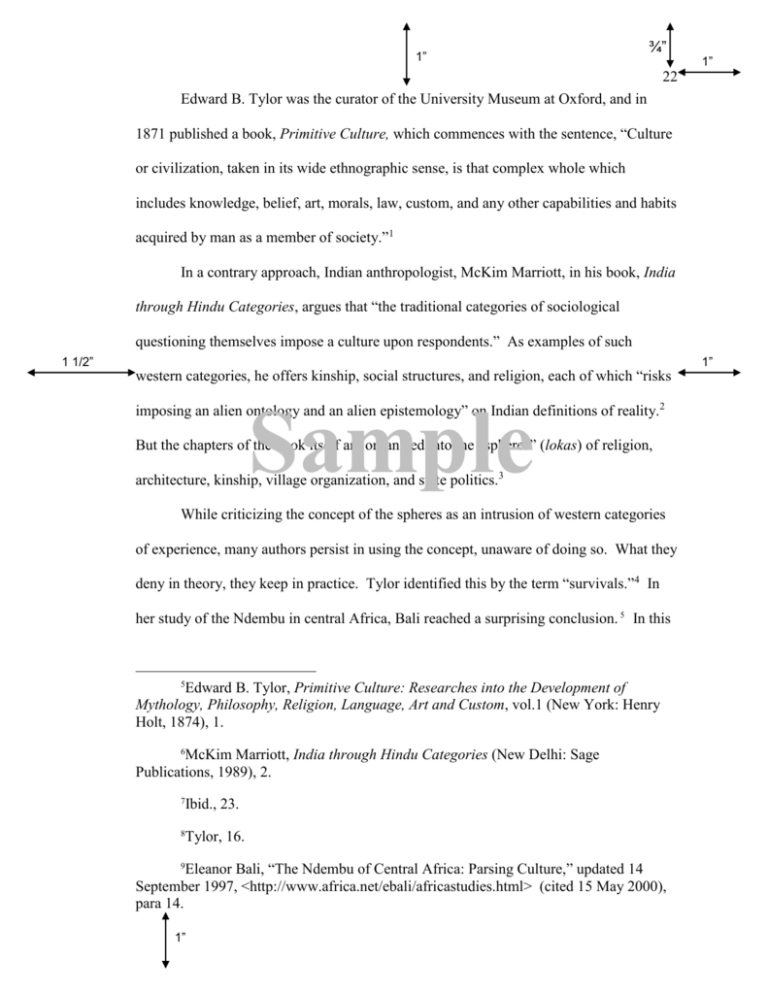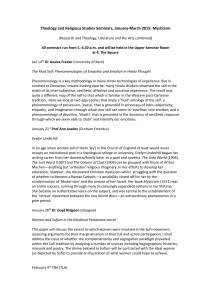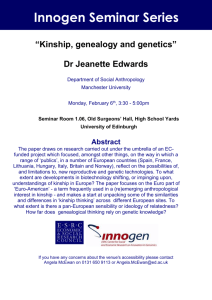Sample
advertisement

1” ¾” 1” 22 Edward B. Tylor was the curator of the University Museum at Oxford, and in 1871 published a book, Primitive Culture, which commences with the sentence, “Culture or civilization, taken in its wide ethnographic sense, is that complex whole which includes knowledge, belief, art, morals, law, custom, and any other capabilities and habits acquired by man as a member of society.”1 In a contrary approach, Indian anthropologist, McKim Marriott, in his book, India through Hindu Categories, argues that “the traditional categories of sociological questioning themselves impose a culture upon respondents.” As examples of such 1 1/2” western categories, he offers kinship, social structures, and religion, each of which “risks imposing an alien ontology and an alien epistemology” on Indian definitions of reality.2 Sample But the chapters of the book itself are organized into the “spheres” (lokas) of religion, architecture, kinship, village organization, and state politics.3 While criticizing the concept of the spheres as an intrusion of western categories of experience, many authors persist in using the concept, unaware of doing so. What they deny in theory, they keep in practice. Tylor identified this by the term “survivals.”4 In her study of the Ndembu in central Africa, Bali reached a surprising conclusion. 5 In this 5 Edward B. Tylor, Primitive Culture: Researches into the Development of Mythology, Philosophy, Religion, Language, Art and Custom, vol.1 (New York: Henry Holt, 1874), 1. 6 McKim Marriott, India through Hindu Categories (New Delhi: Sage Publications, 1989), 2. 7 Ibid., 23. 8 Tylor, 16. Eleanor Bali, “The Ndembu of Central Africa: Parsing Culture,” updated 14 September 1997, <http://www.africa.net/ebali/africastudies.html> (cited 15 May 2000), para 14. 9 1” 1” ¾” 1” 22 Sample All page headings are 2” from top edge Bibliography Alder, Catherine. The Velvet Revolution Five Years Later. 1994. [Online book]. <http://www.library.columbia.edu/czech/alter.htm>. The Bible. Revised Standard Version. Capek, Milic and Karel Hruby, eds. T.G. Masaryk In Perspective. London: SVU Press, 1981. Havel, Vaclav. "The End of the Modern Era," New York Times, 1 May 1992, sec.D, p.3. ________. Letters to Olga. Trans. Paul Wilson. New York: Alfred A Knopf, 1988. ________. Open Letters: Selected Writings 1965-1990. Trans. and ed. Paul Wilson. New York: Vintage Books, 1992. 1 1/2” Kohak, Erazim. "Ashes, Ashes...Central Europe After Forty Years," 121/3 (Spring 1992): 197-215. Little, H. Ganse, Jr. "Ernst Troeltsch and the Scope of Historicism," Journal of Religion, 46/3 (July 1966): 343-364. Miller, Sandra. “Social Theory and Its Antecedents.” Updated 16 May 1998. <http://www.cte.nyu.edu/miller>. Cited 25 Jan. 2000. Rubanowice, Robert J. Crisis in Consciousness: The Thought of Ernst Troeltsch. Tallahasee: University Presses of Florida, 1982. Starr, Bradley E. "The World's Most Perverse Habit: Ernst Troeltsch on Religion in the Conflict of Values.” In Anxiety, Guilt and Freedom: Religious Studies Perspectives (Essays in Honor of Donald Gard), 222-254. Eds. Benjamin J. Hubbard and B.E. Starr. Lanham, Maryland: University Press of America, 1990. Troeltsch, Ernst. Christian Thought: Its History and Application. Ed. F. von Hugel. London: University of London Press, 1923. ________. "Religion, Economics, and Society." In Sociology and Religion: A Book of Readings. Eds. Norman Birnbaum and Gertrud Lenzer, 197-204. Englewood Cliffs, NJ: Prentice Hall, 1969. No less than 1” 1” 1” ¾” 1” 22 In the late nineteenth century, Edward B. Tylor was the curator of the University Museum at Oxford. His book, Primitive Culture, commences with the sentence, “Culture or civilization, taken in its wide ethnographic sense, is that complex whole which includes knowledge, belief, art, morals, law, custom, and any other capabilities and habits acquired by man as a member of society” (1871, 1). In a contrary approach, Indian anthropologist, McKim Marriott argues that “the traditional categories of sociological questioning themselves impose a culture upon respondents.” As examples of such western categories, he offers kinship, social structures, and religion, each of which “risks imposing an alien ontology and an alien epistemology” on Indian definitions of reality 1 1/2” (1989, 2). But the chapters of the book itself are organized into the “spheres” (lokas) of religion, architecture, kinship, village organization, and state politics (1989, 23). Sample While criticizing the concept of the spheres as an intrusion of western categories of experience, many authors persist in using the concept, unaware of doing so. What they deny in theory, they keep in practice. Tylor (1871, 16) identified this by the term “survivals.” In her study of the Ndembu in central Africa, Bali reached a surprising conclusion (1997, 14). Note: On a regular page, the full references as given in this box would not appear. But for the sake of making clear what the parenthetical references above refer to, here are the full citations, which would ordinarily appear at the end of the paper in the List of References: Bali, Eleanor.1997. The Ndembu of central Africa: Parsing culture. Updated 14 September 1997. Accessed 15 May 2000 WWW. Available from http://www.africa.net/ebali/africastudies.html. Marriott, McKim. 1989. India through Hindu categories. New Delhi: Sage Publications. Tylor, Edward B. 1871. Primitive culture: Researches into the development of mythology, philosophy, religion, language, art and custom. New York: Henry Holt. 1” 1” ¾” 1” 22 Sample All page headings are 2” from top edge List of References Alder, Catherine. 1994. The velvet revolution five years later. [book online]. Available from http://www.library.columbia.edu/czech/alter.htm. The Bible. Revised Standard Version Capek, Milic and Karel Hruby, eds. 1981. T.G. Masaryk in perspective. London: SVU Press. Havel, Vaclav. 1988. Letters to Olga. Translated by Paul Wilson. New York: Alfred A Knopf. ________. 1992a. The end of the modern era. New York Times, 1 May 1992, sec. D, p. 3. ________. 1992b. Open letters: Selected writings 1965-1990. Translated and edited by Paul Wilson. New York: Vintage Books. 1 1/2” Kohak, Erazim. 1992. Ashes, ashes . . . Central Europe after forty years. Daedalus : proceedings of the American Academy of Arts and Sciences 121, no. 2: 197-216. Little, H. Ganse, Jr. 1966. Ernst Troeltsch and the scope of historicism. Journal of Religion 46, no. 3: 343-364. Miller, Sandra. 1998. Social theory and its antecedents. Updated 16 May 1998. Accessed 25 January 2000. Available from http://www.cte.nyu.edu/miller. Rubanowice, Robert J. 1982. Crisis in consciousness: The thought of Ernst Troeltsch. Tallahasee: University Presses of Florida. Starr, Bradley E. 1990. The world's most perverse habit: Ernst Troeltsch on religion in the conflict of values. In Anxiety, guilt, and freedom: Religious studies perspectives: Essays in honor of Donald Gard, ed. Benjamin J. Hubbard and B. E. Starr, 222-254. Lanham, Maryland: University Press of America. Troeltsch, Ernst. 1923. Christian thought, its history and application; lectures written for delivery in England during March 1923, by the late Ernst Troeltsch. Edited by Friedrich Hügel. London: University of London Press ltd. ________. 1969. Religion, economics, and society. In Sociology and religion: A book of readings, ed. Norman Birnbaum and Gertrud Lenzer:197-204. Englewood Cliffs, NJ: Prentice Hall. No less than 1” 1”






